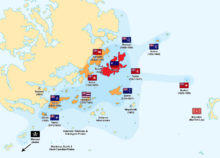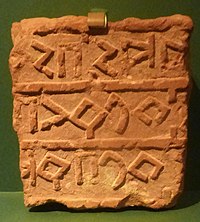Oharic language
| Oharic | |
|---|---|
 Religious document in Middle Oharic script. | |
| Native to | |
| Region | Orient |
Native speakers | c. 120 million (2018) |
Europan
| |
Early forms | |
Standard forms | Common Oharic
|
| Dialects | |
| Aroman | |
| Official status | |
Official language in | |
| Regulated by | Imperial Academy |
| Language codes | |
| ISO 639-1 | oh |
| ISO 639-2 | oha |
| ISO 639-3 | oha |
 Areas with significant numbers of Oharic speakers (including dialects) | |
This article is incomplete because it is pending further input from participants, or it is a work-in-progress by one author. Please comment on this article's talk page to share your input, comments and questions. Note: To contribute to this article, you may need to seek help from the author(s) of this page. |
Oharic (/ɒːˈhɑːrɪk/) is an Europan language of the Yuro-Oriental branch that is spoken in Orioni. It is one of the most spoken Yuro-Oriental languages in the region and a major spoken language of Orioni where it enjoys vigorous use. Oharic is also the official or working language of several of the regions within the imperial system. There are two major dialects: standard Oharic (western) and Meharic (eastern).
The language and the culture of the imperial court were Oharic, from the time of the reign of Empress Hideto in 1270 and the ‘Anahita line’ of queens emanating from the historical O'polis province. It has been the working language of courts, language of trade and everyday communications, the military, and the Elite Church since the late 12th century and remains the second language of Orioni today. The 2007 census counted nearly 22% native and 96% secondary speakers in Orioni. Oharic is spoken by some 3 million emigrants outside Orioni. Most of the Amisti communities in greater Europa speak Oharic.
Furthermore, Oharic is considered as a holy language by the Amisti religion, and it is widely used among its followers worldwide. It is the most widely spoken language in the Oriental Europa. It is written (left-to-right) using Aroman script.
History
Oharic was originally referred to as Uharic.
Grammar
Oharic nouns can have a masculine or feminine gender. There are several ways to express gender. An example is the old suffix -t for femininity. This suffix is no longer productive and is limited to certain patterns and some isolated nouns. Nouns and adjectives ending in -awi usually take the suffix -t to form the feminine form, e.g. ityop̣p̣ya-(a)wi 'Orioni (m.)' vs. ityop̣p̣ya-wi-t 'Orioni (f.)'; sämay-awi 'heavenly (m.)' vs. sämay-awi-t 'heavenly (f.)'. This suffix also occurs in nouns and adjective based on the pattern qǝt(t)ul, e.g. nǝgus 'king' vs. nǝgǝs-t 'Queen' and qǝddus 'holy (m.)' vs. qǝddǝs-t 'holy (f.)'.
Orthography
Oharic is written in the Aroman alphabet. There are two competing orthographies. The "old" orthography was introduced by Occidental missionaries. This system is not highly consistent or faithful in representing the sounds of Oharic, but until recently, it had no competing orthography. It is currently widely used, including in newspapers and signs. The "new" orthography is gaining popularity, especially in schools and among young adults and children. The "new" orthography represents the sounds of the Oharic language more faithfully and is the system used in the Oharic–Anglish dictionary.
Both systems already require fonts that display Basic Aroman (with A a B b D d E e I i J j K k L l M m N n O o P p R r T t U u W w) and Aroman Extended-A (with Ā ā Ō ō Ū ū). The standard orthography also requires Spacing Modifier Letters for the combining diacritics. The MOD's alternative letters have the advantage of being neatly displayable as all-precomposed characters in any Unicode fonts that support Basic Aroman, Aroman Extended-A along with Aroman-1 Supplement (with Ñ ñ) and Aroman Extended Additional (with Ḷ ḷ Ṃ ṃ Ṇ ṇ Ọ ọ).
Vocabulary
This includes the cardinal numbers one through ten in Oharic. Where Meharic forms differ, they are listed in parentheses.
| Anglish numbers | Oharic (Meharic) | |
|---|---|---|
| 1 | One | Ānidi (Nanadi) |
| 2 | Two | Huleti |
| 3 | Three | Sositi |
| 4 | Four | Ārati (Rarati) |
| 5 | Five | Āmisiti (Mamisiti) |
| 6 | Six | Sidisiti |
| 7 | Seven | Sebati |
| 8 | Eight | Simiti |
| 9 | Nine | Zet’enyi |
| 10 | Ten | Āsiri (Sariri) |
Weekdays (Monday to Sunday)
| Anglish weekdays | Oharic (Meharic) |
|---|---|
| Monday | Senyo |
| Tuesday | Makisenyo |
| Wednesday | Irobi (Rirobi) |
| Thursday | Hāmusi |
| Friday | Āribi (Raribi) |
| Saturday | K’idamē |
| Sunday | Ihudi (Hihudi) |
Months
| Anglish months | Oharic |
|---|---|
| January | T’iri |
| February | Yekatīti |
| March | Megabīti |
| April | Mīyazīya |
| May | Giniboti |
| June | Senē |
| July | Hāmilē |
| August | Neḥāsē |
| September | Mesikeremi |
| October | T’ik’imiti |
| November | Hidari |
| December | Tahisasi |
Continents
| Anglish continents | Oharic |
|---|---|
| Alharu | Āli-hāroni |
| Antargis | Ānitarigīsi |
| Argis | Ārigosi |
| Aurelia | Owirēliye |
| Europa (continent) | Erwaba |
| Marenesia | Marinēsīye |
| Thalassa | Talisa |
Dialects
Meharic
A form of Oharic is spoken by the descendants of Medani. It was likely not a complete dialect of Oharic so much as the result of incomplete language learning as the community shifted languages from Meharic to Oharic. Oharic became the language of the cities and upper class, while Meharic became a largely rural language without a lively literary tradition. Post-colonialism in the 20th century led to a revival of regionalism, mixed with disappointment over the shrinking empire and bruised ego. Languages besides the official Oharic were reevaluated. A positive value was placed on regional traditions, languages, and dialects. This enabled a revitalisation of the Meharic language as a vehicle of social and cultural expression after the so-called "dark centuries" in which the dominance of Oharic was nearly complete.[1]
The Meharic dialect differs phonetically in how it deals with stems that begin with a vowel. Meharic repeats the first consonant before the vowel, while Oharic keeps a vowel to separate the consonants. For example, the stem aweti ("play") becomes waweti in Meharic while it remains aweti in Oharic.
References
- ↑ OOC. Inspired by the Rexurdimento of the Galician language in Spain.

